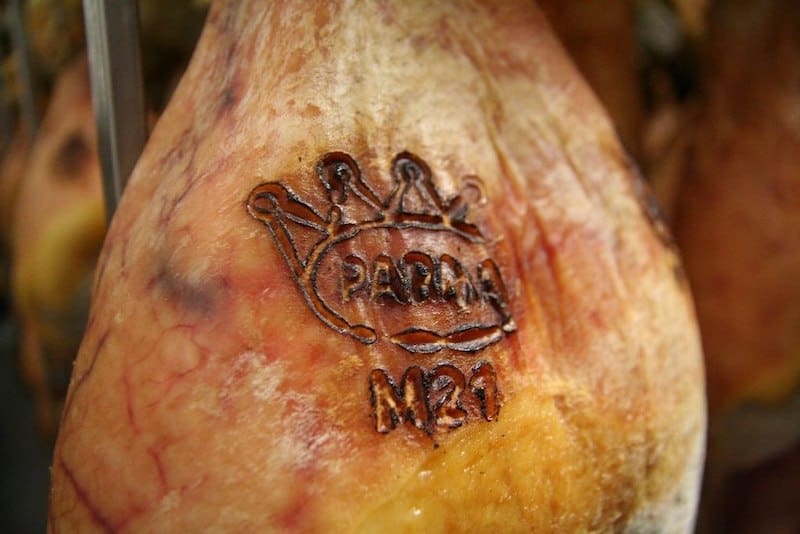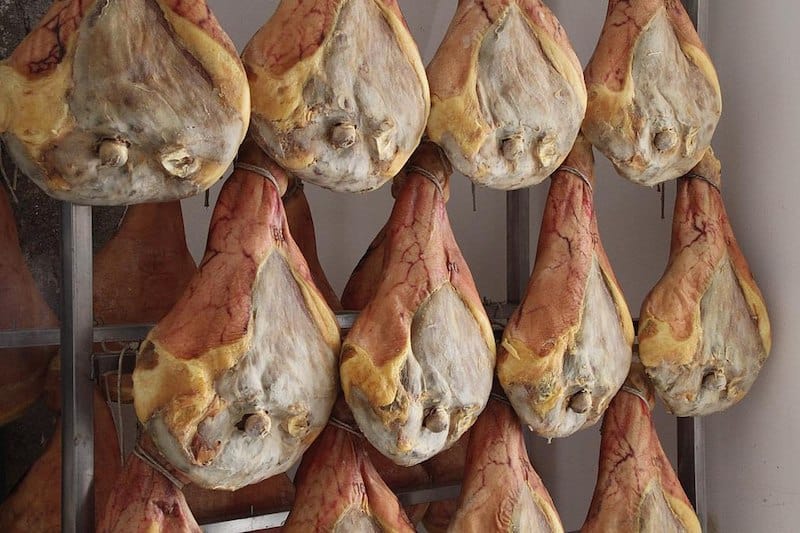Parma Ham vs. Prosciutto: What’s the Difference?
Many people are confused about the Parma ham vs. prosciutto debate.
It’s no wonder, really. “Prosciutto” is literally the Italian word for ham, and Parma is a region in Italy. Simply put, any Parma ham is prosciutto, but not every prosciutto is prosciutto di Parma. Parma ham is only made in the Parma region and should be prepared following specific guidelines.
Here I’ll explain how Parma ham and regular prosciutto are prepared and how to identify real Parma ham. I’ll also answer whether you can substitute one kind for another when cooking.
| Parma Ham (Prosciutto di Parma) | Prosciutto (General) | |
|---|---|---|
| Origin | Parma region, Italy | Any region in Italy |
| Designation | Protected Designation of Origin (PDO) | No specific designation |
| Preparation Ingredients | Only pork and salt | Pork, salt, and sometimes herbs |
| Pig Breed | Landrace and Duroc pigs | Any pig breed |
| Salting | Twice (1 week + another 15-18 days) | Varies but generally involves multiple saltings |
| Curing Duration | Approximately a year or more | Can be up to 36 months depending on size |
| Markings | Five-pointed Ducal Crown mark with the word “Parma” | No specific mark |
| Quality Control | Strictly overseen by the Consorzio del Prosciutto di Parma | General quality standards but less strict |
| Flavor Profile | Unique sweet flavor with a narrow line of creamy fat on one side | Sweet and salty taste which can vary more noticeably |
| Substitutability in US | Can be substituted with regular prosciutto | Can be used as a substitute for Parma ham |
Read on to find out everything you need to know about the Parma ham vs. prosciutto discussion.
Is Parma Ham the Same as Prosciutto?
Prosciutto is a type of dry-cured Italian meat. The word “prosciutto” translates to “ham,” “prosciutto crudo” to “raw ham,” and “prosciutto cotto” to “cooked ham.” In this article, I’ll be talking about traditional prosciutto crudo.
Prosciutto is made from pork legs generously rubbed with salt and herbs. Then, the meat is left to rest in a cool place for a few weeks to remove the excess water. This stops bacteria growth, allowing us to enjoy raw prosciutto safely.
The meat is then washed and the process is repeated. The second time, the meat can be left to cure for up to 36 months, depending on the size. During this time, meat acquires its unique sweet and salty taste.
Parma ham is prosciutto specifically prepared in the Parma region of Italy. As you may have guessed, Parma ham and prosciutto have a lot in common.
Both are made from dry-cured pork legs originating from Italy. The preparation processes are generally the same, yet there are multiple other differences.
Why Is It Called Parma Ham?
As mentioned, Parma ham in Italy is known as prosciutto di Parma and is essentially the same as prosciutto, with a few important distinctions.
Prosciutto can be made in any region, whereas prosciutto di Parma is exclusive to Parma. It’s a Protected Designation of Origin (PDO) food, meaning that it can’t be produced anywhere else.
Prosciutto di Parma is one of the finest hams in the world. When thinly sliced, it melts in the mouth and should have a narrow line of creamy fat running down one side.
Real Parma ham should feature a five-pointed crown mark with the word “Parma,” known as the Ducal Crown. The preparation standards are strictly overseen by the Consorzio del Prosciutto di Parma.

What Is the Difference Between Parma Ham and Prosciutto?
The crux of the prosciutto di Parma vs prosciutto debate lie in the preparation details. The preparation process of Parma ham has stricter guidelines.
Artisans must follow them to receive the Ducal Crown mark. No herbs are used in the preparation of Parma ham: the only ingredients are pork and salt.
While any pig breed can be used for regular prosciutto, Parma ham is made only from Landrace and Duroc pigs.
Meat is first rubbed with salt and left to rest for a week. After the pork is rubbed with the second layer of salt, it’s left to age for another 15-18 days.
Then, the meat is placed in a special cool and dry room for 60-90 days. The excess salt is then washed off and the meat is left to cure for three months.
Afterward, the prosciutto is covered with a mix of lard and salt to prevent the external layer from drying. Finally, the meat is left in a cellar-like room for a year.
Once the curing process is complete, each prosciutto leg is checked thoroughly for quality standards to be called prosciutto di Parma. If the meat passes the test, it’s given the Ducal Crown mark.
The guidelines for regular prosciutto are less strict, and the taste may vary more noticeably as a result.
Can I Substitute Prosciutto for Parma Ham?
Real Parma ham is hard to find in US stores. In most cases, you can substitute Parma ham for prosciutto and likely won’t notice a big difference when the meat is cooked or mixed with other ingredients.
Both types of meat have a melting texture when thinly sliced and a lightly sweet flavor.
However, regular prosciutto is often prepared with herbs, which may give it a slightly different taste and smell.
In Summary
Hopefully, this article has helped you to distinguish between Parma ham and prosciutto.
While these two types of meat are very similar, I suggest you try real Parma ham if you haven’t done so before. It has a unique texture and subtle flavor that can’t be replicated, especially when it comes to prosciutto made outside of Italy.







